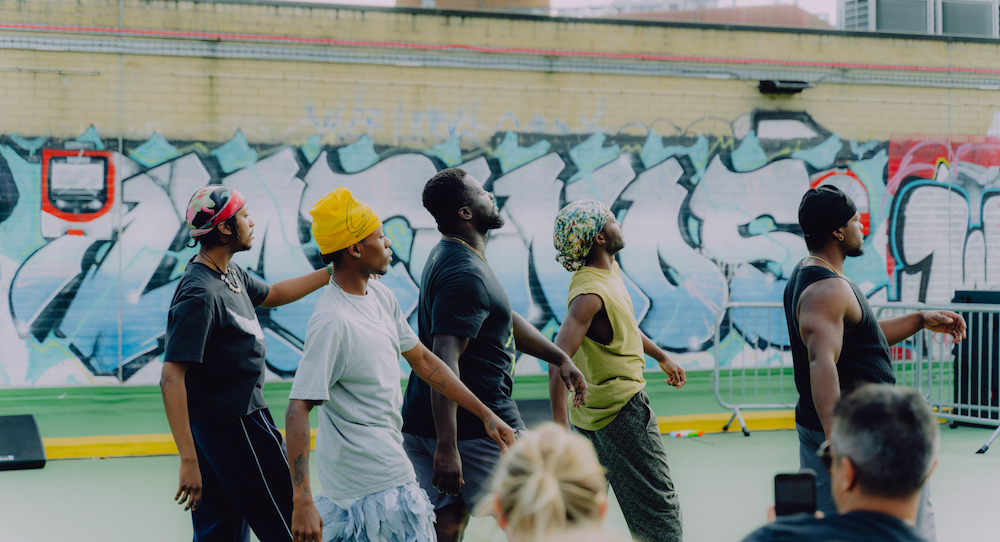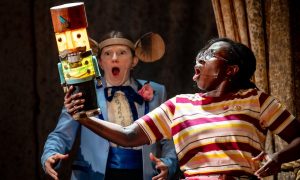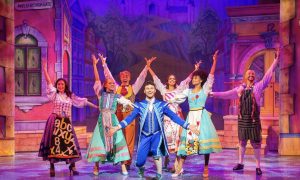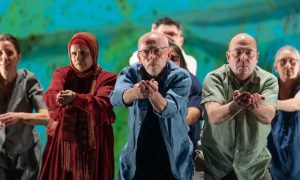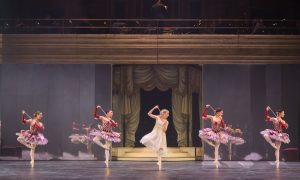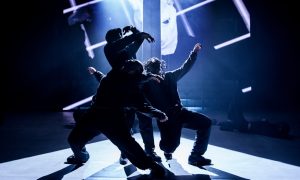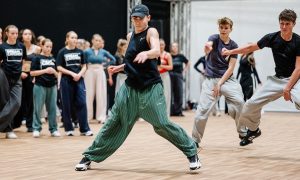Greenwich and Docklands International Festival, London.
6 September 2025.
Celebrating 30 years, the Greenwich and Docklands International Festival (GDIF) returned this year with a diverse range of theatre, circus, and dance, all set over a series of free weekend events.
GDFI launched on August 22, with a breathtaking performance from French company Lézards Bleus titled Above and Beyond. The team worked their way across the South East market town of Woolwich, jumping from rooftops to shop fronts, using Parkour and ensemble work to reach the end destination, where the Greenwich-based Citizens of the World Choir engaged the crowd in song.
The bar was set high, and from what I have seen, GDIF delivered.
The events came to an end with Dancing City, an ‘alfresco dance takeover’ of Stratford, London on September 6th.
Several dance installations were displayed at iconic sites in the London Borough of Newham, East London, including Stratford Town Centre, the East Bank, and Queen Elizabeth Olympic Park. Set against a backdrop of a legacy of buildings, sporting and otherwise, erected for the 2012 Olympics, and new arts and culture establishments, such as the V&A East, and Sadler’s Wells East, I started my day of free dance with Fragments of Us, presented by Talawa, Fubunation and Sonia Hughes.
Fragments of Us examined black masculinity through the lens of five performers, who perfectly demonstrated both joy and struggle through the development of motifs. The audience sat just inches from the performers and, at times, were brought in as the ensemble approached the crowd, sharing their stories and a glimpse into their lives.
This was shortly followed by When Jazz Meets Hip Hop, presented by UEL Dance Collective and in partnership with East London Dance. This was an utter joy to experience. Delivering precisely what the title promised, the choreography encompassed a diverse range of styles, including hip hop, waacking, salsa, jazz, funk, soul, and more.
Dressed in a neutral colour palette, the dance ensemble barely stopped moving unless to highlight a specific moment. Their footwork was light and accurate, reworking the space that Fragments of Us had just used and battling the blazing sun to look effortless. Nothing quite beats London in the Summer.
Choreographed by Jade Hackett, “When Jazz Meets Hip Hop” gave nods to a 1920s/1930s New York, utilising jazz music inspired by the Harlem Renaissance to entertain the crowd.
These two pieces were located about a 10- to 15-minute walk from the other dance spots that made up Dancing City. Once at the main area, there were eight stages featuring performers from all across the globe.
My third performance came in the form of Jungle Boy presented by Levan Peart. There was something raw and powerful about this performance. Dance and animalistic movements collided in a battle that featured four dancers, dressed in black with forest green snoods/balaclavs, employing precise and speedy footwork, mirroring techniques, and other elements to tell this story.
One of self-discovery, healing, and community, the piece almost seemed to evolve from a more primal to a human state through dance by the end. One thing that took this piece to the next level was the addition of a live saxophonist. Any dancer will tell you that performing to live music is an unmatched experience.
The idyllic, sunny, but breezy conditions were the perfect setting for One Sky, my next show to watch, which the UK Pagrav Dance Company presented.
Bringing the spirit of the South Asian kite festival to Stratford, this chorus was a pleasure to watch.
The beautiful narrative piece showcased friends metaphorically creating and flying kites. Their vibrant performance, which married tradition and dance, was set upon a series of elevated plinths with numerous kites behind them. Suggesting they were flying kites way up high on rooftops.
Often gazing up at the ‘kites’ soaring in the sky, the dancers dressed in oranges, reds, and yellows, used changes in tempo, levels, and dynamics to captivate the crowd. The natural heat and wind added to the storytelling, with the cast perfectly blending heritage and modern moves with the story to bring everyone together under ‘one sky’.
The festival boasts an impressive international array of artists, with my next performance coming from Australian production Through Another Lens, presented by Restless Dance Theatre. A seven-strong ensemble of disabled and non-disabled artists, dressed in black, gathered a large crowd as they explored pace and fluidity in a piece designed to encourage the audience to ‘slow down’. Each performer was generous with their energy and time, and often in moments of stillness, dancers would contract to the floor, and in their stillness, all eyes moved to those dancing.
The piece was gentle, with the choreography utilising sweeping motions and delicate touches to explore the ‘negative space’ or unoccupied area around and between the dancers and their movements.
I ended my day of dance with a double-bill straight from the States, and the Fire Island Dance Festival.
Starting with an announcement to share that the Fire Island Dance Festival, which also celebrated its 30th anniversary this year, had raised over $10 million in support towards Dancers Responding to AIDS (DRA) since its creation in 1995, the first performance was A Delicate Balance.
Featuring Swedish choreographer, film-maker and dancer Pontus Lidberg and Cuban-born choreographer and dancer Raúl Reinoso, this intimate and playful duet centred around a class of water that became a beautiful orbit for the pair.
It was a precarious duet, a danced game of cat and mouse, with the ‘game’ resting in moments of intimacy, striking the perfect delicate balance between dance and chemistry.
The glass, which never left the dancers’ touch, was passed and shared between them through complex partnering, which was delivered effortlessly due to the dancers’ solid technique. Both masculine and soft at the same time, this piece was beautiful to watch.
Concluding the double bill was the fabulous Courtney’s Diner presented by Courtney Washington Balenciaga and Masterz at Work Dance Family. A five-piece dance troupe, looking suave in baby pink suits, they strutted the stage and worked the crowd.
The ensemble made up of black, trans, fem and dancers from the LGBTQ+ family, perfectly blended vogue, ball, hip hop and jazz together for a five-minute synchronised piece. The dancers examined the space and all planes of movement, creating light and shade in the choreography with smooth and silky moves, which were met with a change in dynamics through hard-hitting grime and hip hop.
By Jamie Body of Dance Informa.


